Mark Sisson's Blog, page 344
March 29, 2013
I Am Now Blessed with Radiant Health and Boundless Energy
It’s Friday, everyone! And that means another Primal Blueprint Real Life Story from a Mark’s Daily Apple reader. If you have your own success story and would like to share it with me and the Mark’s Daily Apple community please contact me here. I’ll continue to publish these each Friday as long as they keep coming in. Thank you for reading!
 Hi Mark,
Hi Mark,
Growing up with two parents as doctors, I always felt like I had a basic understanding of health and wellness. I was always a lively, active and rambunctious child, but struggled with a myriad of digestive health issues from the early age of 14. My problems seemed to appear during my sophomore year in high school. During the middle of the school year, I transitioned from the Atkins Diet to a full-fledged bout of Mononucleosis (Mono). For four straight weeks, I ate nothing but Jack In The Box milkshakes (Vanilla or Chocolate, sometimes a swirl of both…). When I finally started eating solid food again, my stomach was completely wrecked, and things didn’t work themselves out the way I anticipated. All of the sudden, I had a sluggish digestive system and on the daily was plagued with chronic abdominal discomfort.
When it became apparent that my issues weren’t just a temporary affliction from my illness, my mother and I saw several different gastroenterologists hoping to bring some sort of relief to my seemingly chronic issues. Not one doctor ever mentioned that my abdominal issues could be diet related. NOT ONE. Every physician I saw decided that a supplement of some bark-tasting-sort would be the cure-all-end-all of my issues, and wrote me a prescription and sent me on my way.
After zero success and many dollars down the drain, I started to feel like I was blessed with a body that would cause me pain for the rest of my life. I retained weight, had little energy to get through my day and developed a deep love for a quadruple shot sugar-filled coffee beverage to start my morning.
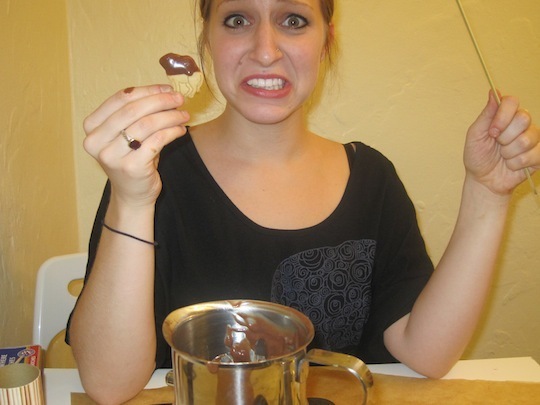
When I was 21, I came home from college on vacation and visited my grandparents in Eugene, Oregon. My grandmother has Celiac Disease, and for the first time, I was inquisitive as to what that actually meant. I picked my grandfather’s brain, and after talking, I became convinced that gluten was the root of all of my problems. I went back to school after doing hours and hours of research and decided to do a controlled study with my diet. I eliminated all gluten-containing products, and almost instantly, it seemed that all of my digestive problems had gone away. After several years of struggling and many visits to the doctor, I was finally sure that I figured out the root of my problems.
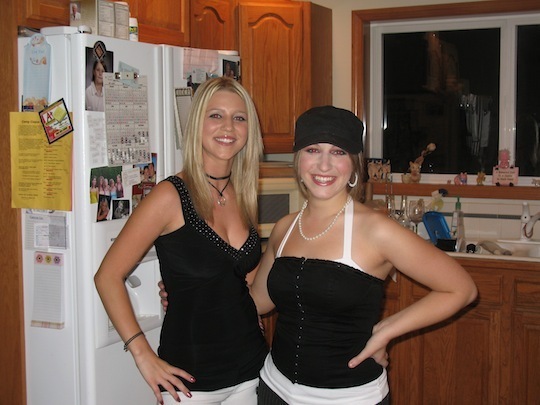
Fast forward another two years. I was 23, graduated from college, traveling the world, teaching yoga and practicing a strict vegetarian diet. I developed adult acne, ovarian cysts, kidney stones and had extreme hormonal imbalance. I was exercising several times a week, and couldn’t sleep enough during the day because of chronic fatigue. I began to think, again, maybe my sickness and lack of well-being has to do with my diet. I started integrating animal protein back into my diet which made me feel 100% better, but all of the sudden, my digestive issues presented themselves again. I was still eating gluten-free, I was doing all of the right things, I thought, and I couldn’t seem to fix the chronic problem. It was infuriating.
To make a short story long, I had the blessed opportunity to stumble upon your website. I had been gluten-free, vegetarian, raw, vegan and anything in between. I finally knew I felt more energized and healthier eating meat, but never considered other grains to have any influence on my gut. I figured if it didn’t have gluten, it was healthy, so I ate my weight in grains, especially corn (psuedo grain), on the daily. I decided to adopt the Primal lifestyle, and it has completely flipped my life upside down.
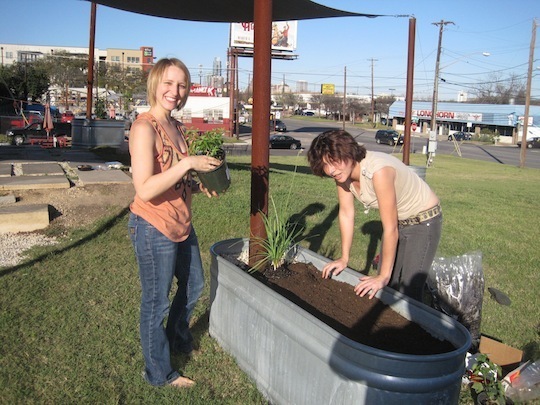
I am now, for the last year and a half, blessed with radiant health, boundless energy and a stomach free of any digestive issues whatsoever. My weight, for the first time in my life, is stable. I am completely off of hormones from birth control, and my mood stays stable and my skin stays clear. I don’t experience brutal hunger pains, and intermittent fasting is easy. My mother, a physician, has also adopted this ancestral lifestyle, and is transitioning out of standard medicine into the field of anti-aging, utilizing ancestral, primal nutritional counseling with her patients. I, at the age of 24, am about two weeks away from opening my first restaurant in Austin, TX called Picnik, a reclaimed shipping container/mobile food truck which is 100% primal, gluten-free and grain-free.
Not only has this information changed my health and wellness forever, it has also catapulted me onto a brand new path in my life and work. I can’t thank you enough for the teachings you provide, and I look forward to seeing you at Picnik!
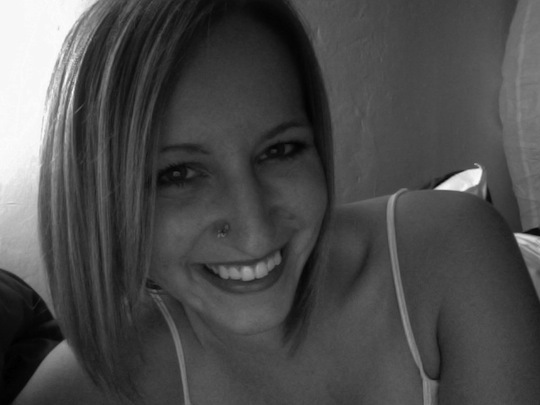
Naomi
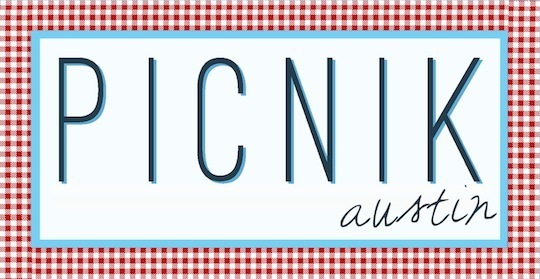
Grab a Copy of The Primal Connection: Follow Your Genetic Blueprint to Health and Happiness Today!

March 28, 2013
Why Health Integrity Matters, or The Power of Being Honest with Yourself
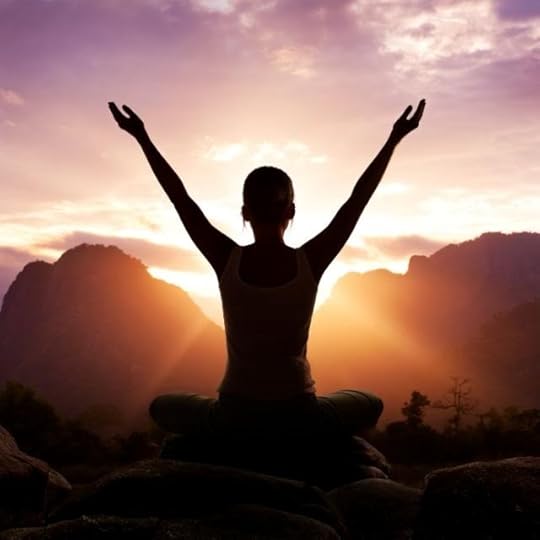
Once upon a hunter-gather time, people generally lived in accordance with what made them healthy. Before we put Grok and his clan on a idyllic pedestal, it’s important to note they had little choice. They otherwise weren’t likely to see the next chapter of the Paleolithic story. Even in the best of personal circumstances and choices, many succumbed to all manner of prehistorical threats. Still, in terms of lifestyle, the health imperative was there. They had to move. They had to eat real food. They lived and slept generally speaking by the cycle of their circadian rhythms. They got sun. They socialized. There just wasn’t reason to question any of it because few if any alternatives existed: next band, same options.
Today we have infinite possibilities, and we suffer as well as benefit a great deal for it. We have the option of sitting on the couch all weekend watching a Game of Thrones marathon. We have the potential to eat at McDonald’s for thirty days straight. We can buy a pack of cigarettes despite the fact we’re hooked up to an oxygen tank. We can have our doctor up our insulin dosage and buy a large Slurpee or a Krispy Kreme on the way home. We can stress ourselves to our last, pathetic nerve (and adrenal exhaustion) by living on too much work, too little sleep, too much worry, and too many stimulants. We have the choice – and that’s exactly what it is: a choice. Whatever our past, whatever our present condition, however, we are always free to make a different next choice.
We can talk physiology until we’re blue in the face. We can read and learn what’s really healthy until we could fill a book or a blog ourselves. We can have a kitchen full of healthy cookbooks. We can listen to our doctors’ most enlightened (shout out to Primal Docs!), encouraging words. In the end, however, it doesn’t come down to know-how or how-tos. It’s about how willing we are to accept personal responsibility for our health.
Responsibility. It’s a hard and, for some, harsh word. In a culture that glorifies rampant immaturity and immediate gratification, the concept can seem like a major buzz kill. When it comes to health, I think the association is especially true. It’s okay to work out, for example, but no one wants to be seen taking it too seriously. Even major athletes joke about the junk they eat and rake in the bucks starring in fast food ads. It’s okay to shell out for grass-fed beef, but the minute you turn down dessert, you’re a killjoy who’s trying to make other people feel bad.
Sure, the massive health problems in our country are in part fueled by false medical messaging that leads well-intentioned people down the wrong roads in search of health. Much of it, however, can simply be attributed to an unwillingness to buck up, take responsibility choice by choice, and live with health integrity. By health integrity, I mean an honesty to one’s self, a commitment that begins and ends with one’s self, an inner compass that has nothing to do with the outside world.
To cultivate that kind of health integrity, we have to acknowledge that everything counts. There are no games, no hiding, no pretending, no excuses. That doesn’t mean people with health integrity don’t eat a dessert sometimes, but there’s no emotional ruse or hand-wringing to it. You own it – for all the good and bad. You don’t blame outside pressures or people. You don’t deal in regret.
Part of the problem is a misplaced fascination with the transgressive. Somehow cheating ourselves is the ultimate gratification. We mistake indulgence for decadence, discipline for deprivation. Healthy behaviors are assigned the boring, white-hat, “moral” role in our culture. Being healthy is about hard work and asceticism. Choosing health is about saying “no.” At least that’s the message we get. On the other side of the spectrum is the Mountain Dew adventure and Doritos-inspired hilarity that could fill our days – if we were only so bold and rebellious.
You live with health integrity when you truly own your journey, when you realize it’s yours and yours alone. You stop living the old blame game and buying into the false dichotomies, the pedantic guilt trips, the bullsh** marketing messages, the cultural labels, the past-imposed limitations and identities. There’s a real freedom in that decision. It doesn’t matter whether you’re at the beginning of your journey with a hundred pounds to lose and a collection of lifestyle conditions to beat or if you’re at your ideal weight and healthy but want to know what it is to thrive in new ways. It’s your journey, and from here on out, you get to define it. You don’t make the rules of physiology, but you do get to design the vision you will live out each day.
In that way, living with health integrity suggests a level of authenticity and self-determination. Once you accept (not the cerebral, oh-it’s-good-for-me kind of logical acknowledgement but the gut-level, psychically moving, surrendering to, kind of assimilation) your journey as your own, you take pride in your health. Cultivating a sense of well-being opens up your life rather than restricts it. It’s not about self-restraint but self-possession. The more you practice and hone it, the more you come into yourself. Discipline encourages creativity rather than resentment. It’s less about control than composure in the face of daily challenges.
Likewise, as much as health integrity calls us to live from a personal center, it doesn’t make us self-centered. When we’re good with our selves, when we have genuine self-respect, we can live in relationships more authentically and productively with others. No longer an enabler to ourselves, we can offer honest and meaningful help to others. Again and again, I hear readers say how much they appreciate the sense of genuine community they feel here, and it’s one of the main reasons I’ve made this my primary vocation. I love to see how people, when empowered themselves, contribute to the empowerment of others. It brings our intention and success full circle, and we can appreciate them all the more in doing so.
Thanks for reading today, everyone. Let me know what you think, and have a great weekend ahead.
Grab a Copy of The Primal Connection: Follow Your Genetic Blueprint to Health and Happiness Today!

March 27, 2013
10 New Primal Blueprint Books (Plus a Prize Package Giveaway)
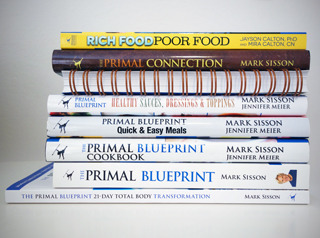
As I mentioned back in my New Year’s post, Primal Blueprint Publishing has launched, and my team and I are on a mission to change lives, one book at a time!
Last month, we released Mira and Jayson Calton’s Rich Food, Poor Food, and early reader feedback has been incredibly positive. With ten more books either nearing release or in development and with many of you emailing me asking for details, I thought I’d take a moment to share with you what I have in the pipeline. Whether you’re just starting or are a Primal veteran, I think there’s something here for everyone.
Prize Package Giveaway
I’d love to hear what you think. In the comment board below, let me know which book you’re most excited about and why, and tell me your idea(s) for a book you think Primal Blueprint Publishing needs to publish. Do those two things and you’ll be entered to win all eight Primal Blueprint books pictured to the right. The lucky winner will be chosen at random. This contest ends at 11:59 pm, Thursday, Mar. 28. Many thanks to everyone that shares their thoughts and, in so doing, helps me make better books for you.
First up, a look at the books with 2013 release dates:
The Hidden Plague, by Tara Grant. This book is for sufferers of Hidradenitis supprativa, a painful skin condition that is poorly understood by the mainstream medical community and strongly associated with the Standard American Diet. Tara suffered for decades before taking matters into her own hands, modifying her diet, and curing herself. There are an estimated 12 million sufferers of this condition in the USA, with many of them unaware of their condition. Tara provides a field guide to managing and overcoming this disease using evolutionary health principles.
Primal Cravings, by Megan and Brandon Keatley. Well the title says it all here! Welcome back all the comfort foods that you’ve disciplined yourself to avoid in pursuit of Primal/paleo dietary principles. This creative, beautifully photographed book is the work of Brandon and Megan Keatley, Crossfit trainers in South Carolina who have dabbled and experimented and reclaimed some of the most indulgent foods you can imagine as Primal/paleo approved! See for yourself, starting with the delicious burger on the cover!
Paleo Primer. This book from the British couple Keris Marsden and Matt Whitmore sets forth the Primal/paleo living principles in a fun, simple manner, making it a great book to introduce newcomers to the movement. It’s filled with creative and delicious recipes, and memorable, humorous cartoons that capture the essence of Primal/paleo living at a glance.
Upcoming Projects
Here’s a look at some exciting projects in development for 2014 release:
Death by Food Pyramid, by Denise Minger. Denise has done numerous guests posts on MDA (Will Eating Whole Grains Help You Live Longer?, Will Eating Red Meat Kill You?), and has her own avid following at her Raw Food SOS blog. Denise has been hard at work for a great many months now on an exquisitely researched expose on how “Shoddy Science, Sketchy Politics, and Shady Special Interest Groups Have Conspired to Ruin the Health of America”, and what you can do to avoid succumbing to such bad influences. She absolutely skewers the bestseller The China Study for their flawed data collection and distorted conclusions, and generally goes to great lengths to set the record straight about the flawed conventional wisdom we have been fed our entire lives.
The South Asian Solution, by Dr. Ronesh Sinha. Dr. Ron, an internal medicine specialist in Los Altos, CA, is doing some great stuff in the Bay Area, treating high risk South Asian patients and Silicon Valley employees with unique solutions that respect the evolutionary health model. South Asians, who are mostly Asian Indians, are one of the most insulin resistant ethnic groups on the planet, with rampant diabetes and early heart disease. His approach has successfully engaged and motivated South Asians to improve their health and reduce their risk while still respecting their cultural lifestyle preferences.
Primal Pregnancy, by Michele Blackwell, MD: This respected Ob/Gyn from Webster, Texas provides a detailed manual for a healthy and successfully pregnancy and childbirth, with a focus on integrating modern medical advice while still adhering to Primal living principles. Dr. Michele will cover a wide range of topics, including fertility, successful conception, all the trimesters, a healthy birth, nursing, and recovering your old self by the time the little one’s first steps are taken.
The Primal Prescription. In this hard-hitting expose on America’s dysfunctional health care system, Dr. Doug McGuff, fitness author and emergency physician from Seneca, South Carolina details how we came to spend over 7 trillion dollars per year on health care, yet rank 49th world wide for health outcomes and life expectancy. Dr. McGuff uses the concept of “signal disruption” to demonstrate how top-down controls have created an unholy alliance between the Government, Big Pharma, Big Agra, and Medical providers to create the ultimate “sick care system”. You will see how government intervention allows Big Agra to create the diseases that Big Pharma produces drugs for, so that doctors can “manage” your illness, so that you can stay just well enough to remain addicted to what made you sick in the first place. Having detailed the road to health care serfdom, Doug will show you the way out. By focusing on yourself and applying Primal lifestyle, dietary and exercise principles you will learn how to extract yourself from the belly of the beast, and enjoy the vibrant health that is your birthright.
Primal Woman, by Carrie Sisson. As I hinted at in a recent post, Carrie is shaping a story that touches on subjects of her particular interest and expertise: aging gracefully, dealing with empty nest syndrome, sorting through misinformation about menopause and hormones that women are subjected to, and fine-tuning the Primal living style from a female perspective. Carrie has a degree in Spiritual Psychology and injects a mystical, spiritual element to some of the everyday topics at hand. I can’t wait to read this! (Nope, I’m not even allowed a peek just yet…).
Perfect Balance, a Primal Approach to Overcoming Negativity with Food, Dieting, and Body Image, by Emily Deans, MD. Dr. Deans is a Massachusetts psychiatrist who explores the causes behind out modern obsession with and, for many, dysfunctional relationship with food. By hormonally, psychologically, and metabolically disengaging from processed food dependency, those who struggle with food issues have a better chance to heal from the psychological factors that contribute to their condition. Perfect Balance helps the reader eat and enjoy great, wholesome, natural foods without trending into a neurotic need to adhere to a Primal or paleo-style diet.
Primal Endurance, by Mark Sisson. Yep, I’m going back to my roots, this time to tell enthusiasts who insist on pursuing extreme endurance goals how to do it right! First and foremost is how to “go long” in training and racing without being a carb addict. Yep, it’s possible to be a high-functioning endurance machine when you become truly fat and keto-adapted. This refreshing concept is raising interest in the staid endurance community, as folks like Ben Greenfield, Dr.’s Phinney and Volek in The Art and Science of Low Carbohydrate Performance, and even the world’s foremost endurance exercise physiologist, Dr. Timothy Noakes of South Africa, are out on the cutting edge spreading the word.
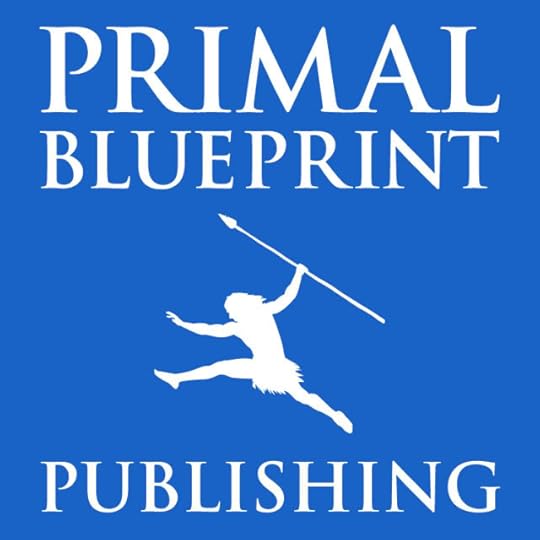
Author Services
I’ve partnered with my old friend Matthew Bennett to provide support to both aspiring authors who want to bring their dream and their story to life, as well as authors who have their manuscript and want to market and sell it effectively. Matthew is a respected coach and lecturer for authors, and a master of creative marketing methods that identify niche volume buyers for your work. Matthew and I are in development with author support products right now, but we want to hear from you in order to present the services and materials that are of most interest. If you are an aspiring author, or have a manuscript that you wish to sell and promote, please take some time to complete the comment form at this Author Services link.
Queries
My team and I are always on the lookout for detailed book proposals or completed manuscripts that promote well being from an evolutionary health perspective. Visit this page for details on how to engage with us about your masterpiece.
Don’t Forget to Share Your Thoughts Below for a Chance to Win a Primal Blueprint Book Prize Package (See Details Above)

March 26, 2013
Primal Abroad: Food Adventures from Around the World
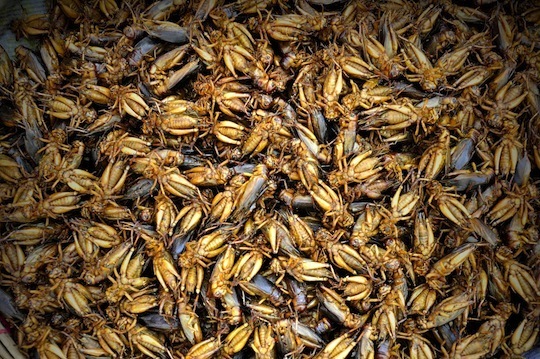
This is a guest post from Eric Bach, primal enthusiast and member of The Modern Gypsies. You may know The Gypsies as the winners of the 2011 adventure race television show Expedition Impossible, and perhaps remember them from this MDA interview. Well, their adventures didn’t end after the show. Since then, they’ve ventured out on a “Compassionate Adventure” of their own making, and have been met with some, let’s say, diverse dishes along the way. Enter Eric.
Ok, so you know the story, eat fresh, organic, unprocessed foods which includes meat, veggies, nuts and seeds. It’s simple and straightforward, the primal way of life is second nature to you. In your neighborhood there’s that quaint little butcher that always has your grass-fed beef, or you can swing by Whole Foods and make a rainbow assortment of varied nuts and seeds; oh and while you’re there, you may as well pick up a can of organic coconut oil. Everything is readily available, taunting you with attractive labels and promises of grass-fed, high omega-3, non GMO goodness.
Now picture this, you’re high up in the Ecuadorian highlands, you just reached the 19,347 ft summit of one of the tallest peaks in the country, Cotopaxi, and after the glorious descent your body is yearning for primal fuel. What are the options? Sure there is a plethora of potatoes and corn (the standard diet of most villagers in Ecuador). However, you just got your ass handed to you by Mount Doom and you need some proper sustenance. After asking local villagers in broken spanglish about the whereabouts of cooked meats, they point to a bag on the ground. You open this bag, expecting freshly grilled goodies, only to discover a pack of adorable, furry Guinea Pig friends. You grew up with a guinea pig, his name was Biscuit and now you are confronted with beautiful childhood memories. Quickly you snap to your senses, wiping the goofy smirk off of your face. Here, Biscuit is food and you’ve got a decision to make.
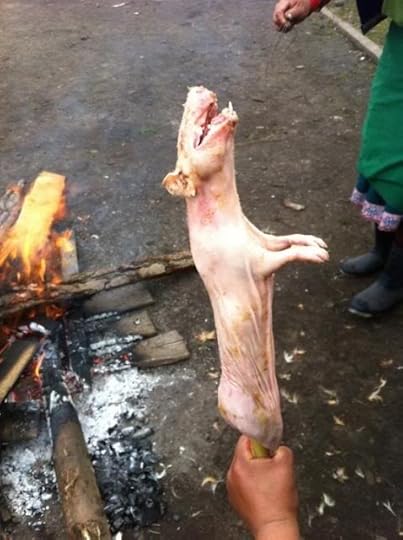
This was the situation that confronted us this past year in Ecuador. Myself, along with my two teammates Taylor Filasky and John Post, had been in the country for several weeks on a “Compassionate Adventure.” Our group, “The Modern Gypsies” had utilized our fan base to vote, raise funds and help to complete a clean water project for over 400 people, as well as summit the stratovolcano, Cotopaxi. Our goal for this trip was to complete one major act of compassion, have one epic adventure and, with a small camera crew, document the experience (guinea pig snacks and all). We truly believe that it is crucially important to not only push your limits physically, but also to give back to the communities whom you encounter along the way. Little did we know, one of the ways we would test our boundaries would be with the long-lost relatives of a childhood pet.
I had been in this questionable consumption situation before; wriggling, fat grubs in Myanmar, Balut (half developed duck embryo) in the Philippines, crickets, chicken heads, scorpions and many unknown meats that I simply cannot put into words (mostly in India). However, staring at a bald, dead guinea pig on a stick, did not give me the traditional Pavlovian salivating response. Then I took a step back and looked at the process. Here we were in the middle of the beautiful Ecuadorian countryside in the tiny village of Gulahuayco. During the days we worked side by side with the men, women and children of the village, digging over 2 kms of trenching and eventually laying the pipe which would bring clean water to the entire community. We were all exhausted; the work was strenuous and our tools for completing the project were…well, they were “primal”. Yet here we were again working side by side, heating up a giant cauldron, husking corn, peeling potatoes and killing guinea pigs (not as glamorous as I make it sound…). Everyone was smiling and laughing, mostly at us. Our common bond was hard work and a desire to better the community.
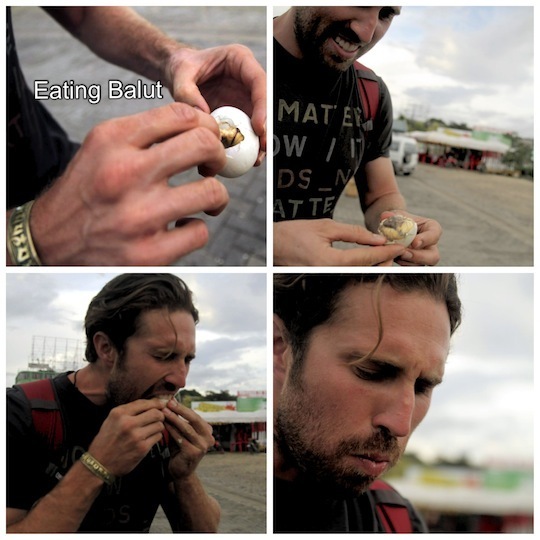
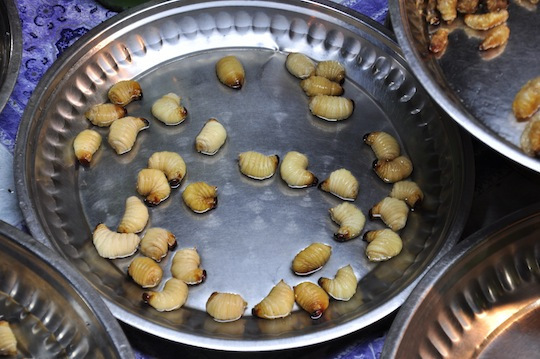
So we went for it. A large group came together in a small dining hall and we all ate together. The guinea pig was tough, but tasted fairly mild, like a chewier, gamier chicken. Thankfully they cut the heads off (which by way of the Ecuadorians were the first to go for some reason). Upon putting a piece in your mouth, you might still end up with a paw or tiny ear, which was cute. While the dish may not be on the top of my list, the experience of eating the meal together is one I will always remember.
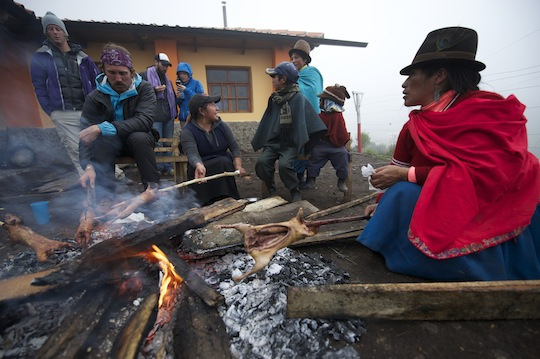
Sometimes in life, we have to make interesting decisions regarding what we put into our mouths. I have been confronted with many of these situations and what I’ve learned is to not think too deeply, or too “Westernized,” into it. Following a primal way of life, we are always thinking about what is going into our mouths and what effect it will have on our body. However, when traveling to exotic corners of the earth, this privileged way of thinking can often be a major hindrance.
As you know, one of the keys to living a successful primal lifestyle is varying your routine. This can come in the form of exercise, diet or life experience. When traveling to foreign lands, partaking in the local dining experience is not just a choice, in my opinion it is your duty. Don’t you worry, you’ll usually have the standard options of chicken, beef, or fish. It’s cool, you know what it will taste like, you know the consistency and your vanilla palette will be satisfied…you did good, you stayed primal! However, in the sense of adventure and life experience, when presented with a more “unique” option, stop thinking and go for it!
Follow The Modern Gypsies on Facebook, and check out the first episode of their Ecuador Compassionate Adventure at TheModernGypsies.com.

March 25, 2013
Dear Mark: Cycling at Work, Refueling After Sprints, Fasting for Caloric Deficit, and PUFAs for Pain
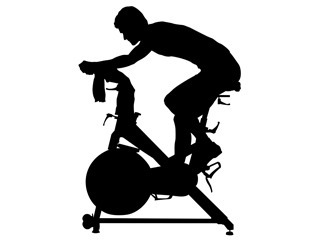 For today’s edition of Dear Mark, I’m tackling four questions. First, I discuss the negative effects of sitting and explore whether stationary cycling as you work can mitigate the bad stuff associated with sitting for too long. Next, I explore how and why a person might want to refuel (or not) after a sprint workout. Should you fast to maximize fat burning or feast to maximize glycogen replenishment? Read on to find out. Third, I field a question from a reader who wants to know whether he should make up for lost calories after a fast, lower his calories, or go with the flow and do what feels best. You probably know what I’m going to say, but you might like reading my reasons why. Finally, I discuss the fatty acid composition of black cumin seed oil and olive leaf oil for a reader who uses both to fight muscle pain. She’s worried about the PUFA content and I try to allay her concerns.
For today’s edition of Dear Mark, I’m tackling four questions. First, I discuss the negative effects of sitting and explore whether stationary cycling as you work can mitigate the bad stuff associated with sitting for too long. Next, I explore how and why a person might want to refuel (or not) after a sprint workout. Should you fast to maximize fat burning or feast to maximize glycogen replenishment? Read on to find out. Third, I field a question from a reader who wants to know whether he should make up for lost calories after a fast, lower his calories, or go with the flow and do what feels best. You probably know what I’m going to say, but you might like reading my reasons why. Finally, I discuss the fatty acid composition of black cumin seed oil and olive leaf oil for a reader who uses both to fight muscle pain. She’s worried about the PUFA content and I try to allay her concerns.
Let’s go:
Hey, Primal Crew! I have a very sedentary job and have been working hard on incorporating standing at my workstation as much as possible. Unfortunately, I also have trouble with one foot due to plantar fasciitis. I have been looking at the Fit Desk bicycle plus desk combination for home so I can get even more active time into my life while trying to finish my next novel. Does biking time count as sitting? If so, I’ll just pad my heels more heavily and go after the treadmill desk instead. But I was really hoping to give my feet a break with the alternative. Any input you have on whether biking counteracts sitting disease would be much appreciated!
Thanks for all you have done for me already!
Rhonda
I’m glad to help you, Rhonda. Anytime.
As for biking and negating the negative effects of sitting, it does and it doesn’t. Allow me to explain.
The problems with sitting are manyfold, and biking addresses a few of them, but not all. What problems with sitting does passive cycling counteract?
The blunted secretion and action of lipoprotein lipase. Normally, when people are walking around, gardening, shopping, doing housework, and just basically engaging their musculature in non-exercise movement, lipoprotein lipase is active in the muscles being used. This allows you to burn fat for energy (since, well, you’re active at a low level, which relies primarily on fat for energy). When you stop moving, your muscles stop producing lipoprotein lipase (since, well, they have no real need to burn lots of fat for energy). Cycling demands lots of activity from your legs, even though you’re technically sitting, so lipoprotein lipase should remain active.
What problems with sitting does passive cycling fail to counteract?
Shortened, tightened hip flexors. One major problem with sitting for too long is the position into which it places your hips: a super flexed position, with the angle between your hips and your torso shortened. That’s why sitting for too long and then trying to go exercise can open you up to injuries – your ability to fully extend your hips is hampered and your other tissues will pick up the slack and throw something out of whack. Biking isn’t really all that different, as a perusal of biking forums will quickly show. Cyclists commonly complain about tight hip flexors. Now, since you’ll be upright, rather than hunched over roadbike-style, your hips won’t be quite so short. Make sure you hit the couch stretch at the end and beginning of every day to make up for all the sitting.
What am I not totally sure about?
Reduced insulin action. When you sit and eat, your ability to use insulin is reduced. It takes more insulin to clear glucose from the meal you just ate when sitting than when standing. I strongly suspect that cycling will mitigate this since you’re active and using your muscles, but I can’t be sure.
The lowered satiety response to meals. I don’t have a study showing this, but I do have one showing that sitting during and after a meal reduces satiety and promotes overeating when compared to standing during and after a meal. Since the primary difference is the level of activity, I’m guessing that passive cycling is roughly analogous to standing in this respect.
Slack, inactive glutes. Sitting famously inactivates your glutes, since you’re literally sitting on them without engagement (as you would, say, in the bottom of a squat). Cycling can utilize the glutes, but it often requires actively engaging them as you pedal. Most cyclists do not use their glutes to pedal, not nearly enough, which is why cyclists with massive quads and flat butts are pretty common. You might try actively pulling with your hamstrings and glutes while trying your hardest not to use your quads until you’re confident you can engage your glutes.
Overall, I’d say cycling as you type is better than sitting, but I’d still break up the monotony and get up and move around as often as you can. We’re simply not “meant” to remain in the same position for hours on end (even if we’re moving), and I suspect messing with that can have negative effects on our health.
P.S. We just added four TreadDesks to the Primal Blueprint offices. The crew is loving them. Maybe I’ll do a full-on TreadDesk review post somewhere down the line if there’s interest.
Mark,
I have a question on the interaction of diet and exercise within the PB realm. I exercise in the morning before work and the days where I lift heavy things I usually follow up my exercise with a pretty solid breakfast of fats, protein, and some carbs. On my off-days, I usually just walk in the morning and will typically continue my fast until I get hungry later in the morning or lunch time. My question is around sprint days. Should I eat after a sprint day like a lift-heavy-things kind of day or like a walking day…or mix it up? I imagine Grok exerted himself with no immediate food gain afterwards [running away from a Saber tooth?], so I don’t think I’m negatively impacting my health but I’m not sure.
Grok on!
Mike
Well, it depends on what you want to accomplish. Going without food after a sprint shouldn’t negatively impact your health, and it might even improve your fat burning and boost your growth hormone production.
Generally, sprinting is going to deplete muscle glycogen, at least from the muscles that you’re using to propel yourself forward. So hamstrings, quads, glutes, calves, and even your arms (all that pumping) will burn through a good chunk of their glycogen stores. You’re going to want to eventually replenish that glycogen, and doing so in the immediate post workout window (1-2 hours) is the most efficient way to do it. In the first 30 minutes, you can actually refill glycogen without needing much insulin. After that, muscle insulin sensitivity remains elevated for awhile – in rats, 50% of their muscles’ increased glucose uptake is preserved at 18 hours post workout. So don’t think you have to go and eat everything right away or have your muscles forever locked away.
However, a glycogen depleted muscle will be a weaker muscle, particularly if it’s a fast twitch muscle fiber (the type of fiber that sprinting preferentially targets), so if you need to perform right away or need to recover for the next day’s activities, you may want to eat.
It all comes down to your goals and your needs. If you’re a performance athlete who needs to be ready to perform again tomorrow, take advantage of the post-sprint window and eat a bunch of carbs and protein for glycogen replenishment. If you’re trying to maximize fat loss, a couple hours of fasting will maximize growth hormone release and might be ideal (although eating a modest post workout meal shouldn’t affect your fat loss much, as the bulk of the glucose you consume will be shuttled into your muscles without even necessarily requiring insulin to do it at first). And you can still replenish your glycogen later that day. It just won’t be quite so efficient.
I’d mix it up. Keep eating your fat, protein, and carbs on the really intense sprint days but toss in a couple days where you fast for a couple hours postworkout. Go by how you feel, ultimately. I’m a firm believer that your body will tell you what you need, especially after training.
Mark,
The question I have regards intermittent fasting. I have not started it yet but would like to. My question is, if someone normally consumes 2,100 calories a day and does intermittent fasting, say from Sunday at 6 pm until Monday at 12 pm, should you still consume 2,100 calories throughout the rest of the afternoon and night on that Monday (or the days one fasts), or are you supposed to subtract the calories you would normally eat in the morning from the total calories eaten in a day, 2,100 in this instance?
Thank you,
Dave
I think you should try to eat your normal amount. Don’t stuff yourself or force the food down, but don’t arbitrarily limit yourself either. Fasting is a potent stressor, one that we can recover from and grow stronger in the process (a la hormesis), but only if we nourish ourselves. Don’t let fasting become starvation.
Plus, there’s some evidence that even when caloric intake is steady, even when you’re eating as much as you would otherwise, simply reducing your meal frequency (i.e., fasting) can elicit favorable changes to body composition (less fat mass and body weight) and have mixed effects on cardiovascular disease risk (slightly increased blood pressure and LDL, increased HDL). In another study, rats on a high-fat diet that normally induces metabolic syndrome and obesity were protected from the usual negative metabolic effects by eating in a time-restricted fashion. Meanwhile, the rats who ate the same amount of calories on the same kind of diet without a restricted eating window suffered from obesity, hyperinsulinemia, inflammation, fatty liver, and impaired motor control.
Don’t overthink it. It’s not an exact science, or a system that requires obsessive tracking. It’s just a way to streamline your eating, to make things easier, to actually remove all the guesswork and intense focus on food so that you can relax and spend time doing other things. That’s how I see it, anyway. Some people use IF to make attaining a caloric deficit easier. With a truncated eating window, eating the same or similar amounts of food simply grows more difficult.
Black seed oil and olive leaf oil help me immensely with muscle pain. Are they dangerous PUFAs? Thanks so much.
Wendy
Black seed oil comes from the black cumin seed, known as nigella sativa. Cumin is a potent antioxidant spice that provides incredible flavor and several health benefits, many of which I outlined in my previous post on the subject, but black cumin is not to be confused with cumin.
Like cumin, though, black cumin is a spice with impressive antioxidant compounds and extensive medicinal history throughout the Mediterranean. It’s a broad-spectrum antimicrobial, effective even against antibiotic resistant bacteria. According to a review on its pharmacological effects, black cumin may improve hemoglobin levels, increase respiration, lower blood pressure, and improve lipids. It’s also been shown to reduce inflammation. One recent placebo-controlled study found that black cumin seed oil was effective against rheumatoid arthritis, which makes me think of your finding that it helps with pain.
As for the oil, it’s pretty high in PUFAs. A recent analysis of black cumin seed oil found that it was 42.76% linoleic acid (PUFA), 16.59% oleic acid (MUFA), 8.51% palmitic acid (SFA), and it even had some EPA (5.98%) and DHA (2.97%). If you’ve got serious pain issues and it’s helping, I probably wouldn’t let the PUFA content dissuade you. However, if you’re just trying to ease sore muscles after a workout, the fact that black cumin is reducing inflammation might mean it’s also reducing your adaptation to exercise.
I wasn’t able to find anything about olive leaf oil, but I would assume that it has a fairly similar fatty acid profile to olive oil – mostly monounsaturated fats with a bit of saturated and polyunsaturated fat. Again, if it’s helping, don’t worry about any PUFAs (which are bound to be low anyway).
Thanks for reading, guys. That’s it for today. Be sure to leave a comment!
Grab a copy of Primal Blueprint Quick & Easy Meals for over 100 Primal Recipes You Can Prepare in 30 Minutes or Less

March 24, 2013
Weekend Link Love
 Research of the Week
Research of the WeekIt seems that Victorian-era rural Englanders had pretty great life expectations (roughly equal to modern day Brits) thanks to their hearty (4k+ calories per day) whole foods diets and regular physical activity.
Humans have unique brain structures that are not found in monkeys, who also do not have any analogous structures that perform similar roles. Pretty cool.
In an observational study, skim and low-fat milk were associated with more childhood obesity than whole and 2% milk.
Interesting Blog Posts
It’s really not that hard, is it?
Other areas of life exist besides the gym, the toilet, and the bus stop where squatting can be helpful and biologically appropriate.
Media, Schmedia
Let them eat fat, they say. Does anyone else sense a shift?
Australia may have drop bears, poisonous spiders the size of your face, and murderous fauna lurking in every corner of the country, but they might also get the first paleo franchise restaurant chain.
Everything Else
This is one kind of paleo reenactment that I can probably get behind: The Primitive, a modern knife inspired by paleolithic design.
Are you a New Yorker who has had success on a paleo diet? Dr. Oz wants to hear from you. If you fill out the form, mention me and maybe we’ll end up on the show together.
Recipe Corner
Eat your balsamic lamb heart salad out.
Figgy bacon burgers. Aren’t those technically figgy piggy burgers?
Time Capsule
One year ago (Mar 24 – Mar 30)
Maybe There Is Such a Thing As Too Much Information – How much do you want to know about your genes, and how much of the information is even reliable or actionable?
6 Books I Am Reading Right Now – It’s always good to branch out and read stuff other than this blog from time to time.
Comment of the Week
Okay Mark, you just got me to crawl around on my hands and knees for 10 minutes. I did not think there was a man alive who could make me do that!
- I’m just full of surprises.
Get All Three Primal Cookbooks, an Apron and More in The Primal Blueprint Chef Kit Today!

March 23, 2013
Smoked Bacon Oysters
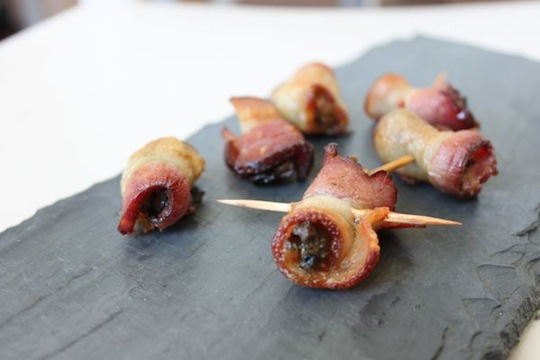 Smoked Bacon Oysters are crispy little morsels of pure pleasure, an addictive snack and appetizer, or a tasty breakfast side for scrambled eggs.
Smoked Bacon Oysters are crispy little morsels of pure pleasure, an addictive snack and appetizer, or a tasty breakfast side for scrambled eggs.
The flavor of bacon dominates (never a bad thing). Smoked oysters add a sweet and smoky flavor that pairs perfectly with the salty bacon. The texture is also perfect: crispy bacon and a creamy melt-in-your-mouth oyster middle.
This recipe can potentially serve 4 as an appetizer, but only if you have enough willpower not to pop half of them in your own mouth right out of the oven.
Serves: 4, as a light appetizer
Time in the Kitchen: 30 minutes
Ingredients:
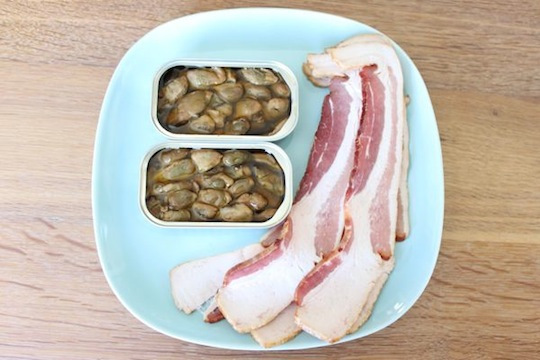
2 tins smoked oysters* (3 ounces/85 grams each)
8 strips of bacon (12 ounces/340 g)
* When buying smoked oysters, look for brands packed in olive oil rather than cottonseed or other oils.
Instructions:
Preheat oven to 400º F (204 ºC).
Drain the oil from the oysters.
Wrap each oyster in a single layer of bacon. If some oysters are especially small, wrap up two of them together.
To wrap the oysters set an oyster on the end of a piece of bacon. Roll the strip of bacon once so it wraps the oyster in a single layer. Use a toothpick to secure the bacon around the oyster. Use scissors (the easiest way) or a knife to cut the wrapped oyster off from the remaining bacon strip. One strip of bacon will wrap about 3 oysters.

Set the wrapped oysters on a broiler pan.
(A broiler pan works better than a regular pan because the grease will drip through the holes to the pan below. In a regular pan, the grease pools around the oysters, making them greasier and less crispy. If you don’t have a broiler pan, you can bake the oysters on a cooling rack set on a rimmed sheet pan.)
Bake the oysters for about 20 minutes, until the bacon is crisp.
These bacon wrapped oysters taste best right out of the oven, but are still tasty at room temperature.

Get All Three Primal Cookbooks, an Apron and More in The Primal Blueprint Chef Kit Today!

March 22, 2013
How the 21-Day Challenge Helped Me
It’s Friday, everyone! And that means another Primal Blueprint Real Life Story from a Mark’s Daily Apple reader. If you have your own success story and would like to share it with me and the Mark’s Daily Apple community please contact me here. I’ll continue to publish these each Friday as long as they keep coming in. Thank you for reading!
 Hi Mark,
Hi Mark,
I’ve been slowly getting my feet wet with the paleo/primal nutritional way of living for around a year now. It started with a better way of cutting the highly addictive sugar out of my diet. Many of those types of diets don’t address the need for higher fat consumption though and they don’t consider behavioral changes that need to be made as well.
If I want to tell my weight loss journey story right, I have to start at the beginning. I was obese my entire life. I remember being called “Miss Piggy” in second grade by classmates. I remember writing to diet and weight loss scam ads in the back of teen magazines begging for help as a preteen. But nothing ever changed and I stayed obese until I moved across the country (away from my family’s environment) and started the process at the age of 26. My entire family is obese, so I have to admit that I didn’t see a lot of hope for losing weight based on lies my Mom shared with us our wholes lives (that we are supposed to be this way).
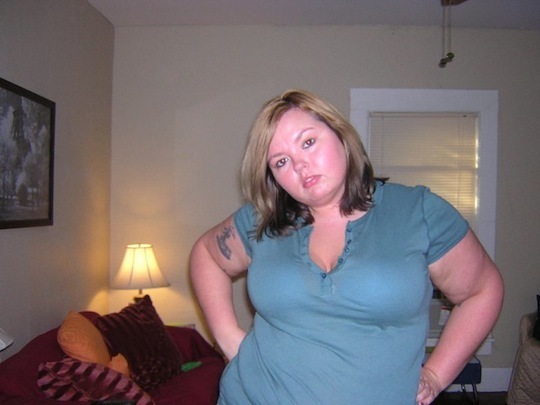
When I started my weight loss journey, it was not the healthiest choice I could have made in going about doing it. I joined a local gym (the first one I had ever stepped foot into) and started doing repetitive cardio before going to work and after work each day (6 days a week). I also worked 8 hours a day on my feet. I tracked everything I ate obsessively and broke down every macronutrient. I strived to eat 1200-1400 calories a day with a 30/40/30 ratio. I wore a heart rate monitor 24/7 to make sure that I expended more calories than I consumed each day. I was preoccupied with becoming my own “biggest loser” and whipping the weight off of me as quickly as possible. And I did. It took me around seven months to go from 285 pounds to 154. On the outside, this appeared to be a great success, but on the inside I caused new problems for myself.
Some problems that resulted:
I was so focused on losing weight and exercising that my relationship failed.
The result of a lifetime of being obese and losing weight very quickly left me with loose skin. I felt defeated that I still was not happy with my appearance even after all of the hard work and dedication. I will never look good naked.
My obsession with tracking food and restricting what I ate caused disordered eating patterns for me. I suffered with bouts of binge eating for the next two years during stressful times. The only way I managed to keep the binge weight off was to go back to restricted eating again and excessive exercise (like running marathons).
In an effort to try to get over my preoccupation with food (especially sugars), I read every sugar addiction book available and even attended Overeaters Anonymous meetings for four months. The meetings were inviting and helpful at first, but then they stopped helping because everyone wallowed in their own self-pity about their addiction to donuts or ice cream. It just made me want to run to comfort food even more. The books were insightful, but the diets they promoted were not. I could not give up all refined sugars and keep the rest of my diet the same.
Around this time, I ventured into the paleo lifestyle and it made more sense to me, but like most people, I was scared to start eating that much fat in my diet (no matter if it was healthy or not). So, I introduced certain ideas from the paleo plans into my life slowly. I started eating more organic meat, avocados, nuts, and eggs. The problem was that I still had grains, legumes, soy, and sweeteners in my diet. After a few more months, I read somewhere that the paleo diet was actually credited with helping some people with eating disorders to overcome them. Maybe this was the golden ticket I was looking for?
I began to realize that living healthy wasn’t just about eating healthy and working out. It was a complete behavior shift. I suffer from Obsessive-Compulsive Personality Disorder (not OCD), so I tend to be perfectionistic and rigid in my way of living anyways. My goal has been to accept myself the way that I am and have more compassion for myself when I fail and allow my life to just flow instead of being scheduled all of the time.
How the 21-day challenge helped me:
I finally gave up stevia in my morning coffee/tea.
I finally gave up my morning oatmeal for eggs.
When I am hungry, I have the mindset now to eat something with more fat and protein.
I stand at my desk now for at least 2 or 3 hours a day.
I take time to myself now to avoid getting too overwhelmed or stressed out.
I ask for help from my fiancé with chores around the house.
I can now do over 40 pushups in a row.
I still cannot do a full pull-up, but I’m getting closer!
I can see my abs for the first time in my life.
I don’t need to obsessively workout.
I’ve started fermenting my own sauerkraut.
I purchased a slackline and use it for fun and entertainment with friends.
I spend more quality time with my fiancé (not talking about food or exercise).
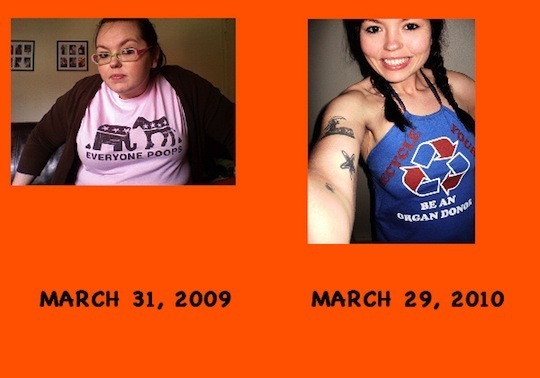
My journey has not been easy. When people ask me how I lost the weight, I could say “With diet and exercise”, but that really discounts all of the physical and mental struggle and anguish I went through because I chose to lose weight the somewhat unhealthy way and I have a personality disorder that controls much of how I behave on any given day. The paleo nutrition plan is simple, which is great because I tend to over-complicate things. It was really hard for me to believe that something so easy could actually work. But I figured that 21 days of eating and behaving this way couldn’t hurt to try.
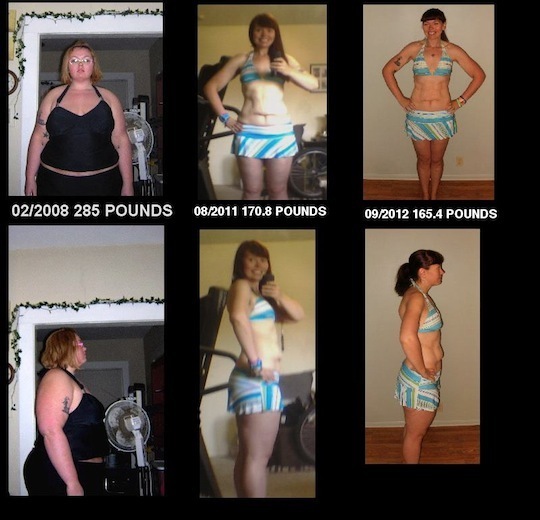
After a full month of eating paleo, I weighed and measured myself for the first time. I dropped 8 pounds on the scale and am currently at my lowest body fat percentage. Even when I weighed 154 pounds, my body fat was slightly higher than what it is now at 165 pounds. The best part is the difference I could see in my “after” photos this time. I can actually see more definition in my stomach and arms. A friend also kindly pointed out to me that she noticed a big difference also… I’m smiling! I never smiled when I was obese.
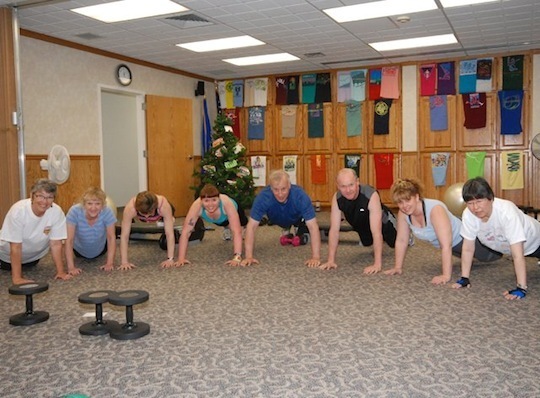
Thank you Mark and the whole paleo community for opening my eyes to an easier way of living my healthiest life (mentally and physically)! I hope to be able to write to you in the future to let you know that the disordered eating patterns have completely vanished (and I’ve gotten even healthier).
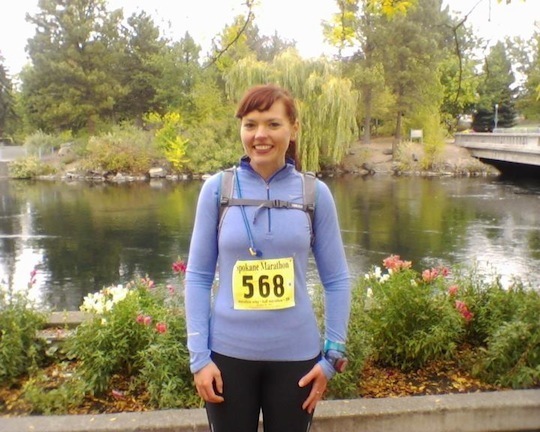
Sincerely,
Naomi
Start Your Own 21-Day Challenge Today! Order a copy of The Primal Blueprint 21-Day Total Body Transformation for the Complete Program.

March 21, 2013
Do Fear and Anxiety Define Your Health Journey?
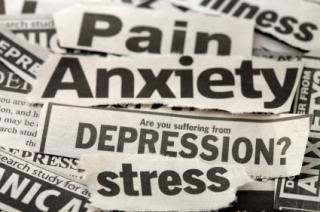 Think for a minute about the health messaging sources in our culture. Think of the pharmaceutical ads in every magazine and television show. Think of the medical talk shows and evening exposes on obscure conditions, the nightly newscasts depicting the ravages of epidemics in far flung corners of the globe and “expert” sound bytes warning of pathogens closer to home. Then there are the messages themselves. How many doom and gloom health statistics and inflammatory stock images do you encounter in a day? How many times do you hear “Ask your doctor if [insert medication] is right for you”? This doesn’t, of course, even begin to scratch the surface, but you get my point. Aside from the marketing blitzes telling us why this pharmaceutical is the next best thing or this box of snack food is heart healthy (hint: it’s not), the most commonly viewed/heard “health” related information spinning around in our culture paints a pretty negative, agitating picture.
Think for a minute about the health messaging sources in our culture. Think of the pharmaceutical ads in every magazine and television show. Think of the medical talk shows and evening exposes on obscure conditions, the nightly newscasts depicting the ravages of epidemics in far flung corners of the globe and “expert” sound bytes warning of pathogens closer to home. Then there are the messages themselves. How many doom and gloom health statistics and inflammatory stock images do you encounter in a day? How many times do you hear “Ask your doctor if [insert medication] is right for you”? This doesn’t, of course, even begin to scratch the surface, but you get my point. Aside from the marketing blitzes telling us why this pharmaceutical is the next best thing or this box of snack food is heart healthy (hint: it’s not), the most commonly viewed/heard “health” related information spinning around in our culture paints a pretty negative, agitating picture.
On an individual level, some people are genuinely facing emergency level, literally do-or-die situations. It might be the diagnosis of an acute condition or the long seen crescendo of a chronic, un-/under-attended lifestyle disease. But too often, we’re gripped by an anxiety beyond reason, without reason. On the clinical end of the spectrum, experts estimate about 1-2% of the population suffers from what’s considered “pathological health anxiety,” although it’s likely around 10% for people who have had serious health problems in the past. True hypochondria can be destructive enough to unravel a person’s life, and experts agree the condition is fed by fears that go much deeper than the latest health headlines.
Beyond this extreme condition, however, are the “worried well” among us who request unwarranted, radiation-laden scans, risky medications, and unnecessary labs because we’re so anxious about our health. Sure, sometimes it’s doctors who fear litigation if they don’t go down every avenue or hospitals who want to profit from expensive testing procedures, but it’s often the will of the patients, too. Increasingly, it’s the patient who’s looking to go down a checklist of his own. Blame the ratings-hungry sensationalist media, self-diagnosis on the Internet, or the general sense that we’re all going to hell in a hand basket.
All this hand-wringing, however, doesn’t seem to do much good in the collective sense. It’s enough to trump up fear and loathing but not enough to inspire much meaningful lifestyle change. Our anxiety is too often misplaced. We have no problem eating fast food multiple times a week, but fear the flu or the next pandemic is waiting to grab us like the bogeyman in the night. Ebola is a mere plane flight away from stealing our children. Food poisoning is lurking in every meal. We can never have enough triclosan, Purell, or antibiotics to quiet our nerves, but here’s a caramel mochachino to take the edge off.
The backdrop on all this, of course, is the real state of affairs. We’re in sad physiological shape as a society, and that’s the understatement of the century. Truth be told, we have plenty of reason to worry – except worry isn’t the answer. No one ever gets healthy cowering in a corner or gnashing their teeth. I think you have to opt out of the game in general – the fear, the escapism, the distraction, the preoccupation. It’s instead about embracing something else entirely.
Rejecting health anxiety isn’t about putting our heads in the sand. The effective opposite of anxiety isn’t denial. It’s reason, power, perspective. I’d argue it’s about learning to read the reality behind statistics, realizing what’s worth your concern and what’s not, and then taking responsibility for today – right now. You have to stop dodging what you don’t want and take what you do. It’s about embracing the life you want for yourself and fixing your attention on that every day. Whether you see health through a lens of fear or aspiration, that’s the principle that will define – or limit – it.
One last musing, and let me know your thoughts on this. I wonder what the results would be if a study was conducted on people who were either exposed to all of the anxiety-provoking, disease-focused messages of our culture or to only positive messages about thriving and enjoying health. Anxiety versus enthusiasm, if you will. Which group would end up making the healthier choices? Which group would end up not only better adjusted but less medicated? Which group would feel more in control of their well-being and actually use that control to their advantage?
Thanks for reading, everyone. Have a great end to the week.
Grab a Copy of The Primal Connection: Follow Your Genetic Blueprint to Health and Happiness Today!

Does Fear and Anxiety Define Your Health Journey?
 Think for a minute about the health messaging sources in our culture. Think of the pharmaceutical ads in every magazine and television show. Think of the medical talk shows and evening exposes on obscure conditions, the nightly newscasts depicting the ravages of epidemics in far flung corners of the globe and “expert” sound bytes warning of pathogens closer to home. Then there are the messages themselves. How many doom and gloom health statistics and inflammatory stock images do you encounter in a day? How many times do you hear “Ask your doctor if [insert medication] is right for you”? This doesn’t, of course, even begin to scratch the surface, but you get my point. Aside from the marketing blitzes telling us why this pharmaceutical is the next best thing or this box of snack food is heart healthy (hint: it’s not), the most commonly viewed/heard “health” related information spinning around in our culture paints a pretty negative, agitating picture.
Think for a minute about the health messaging sources in our culture. Think of the pharmaceutical ads in every magazine and television show. Think of the medical talk shows and evening exposes on obscure conditions, the nightly newscasts depicting the ravages of epidemics in far flung corners of the globe and “expert” sound bytes warning of pathogens closer to home. Then there are the messages themselves. How many doom and gloom health statistics and inflammatory stock images do you encounter in a day? How many times do you hear “Ask your doctor if [insert medication] is right for you”? This doesn’t, of course, even begin to scratch the surface, but you get my point. Aside from the marketing blitzes telling us why this pharmaceutical is the next best thing or this box of snack food is heart healthy (hint: it’s not), the most commonly viewed/heard “health” related information spinning around in our culture paints a pretty negative, agitating picture.
On an individual level, some people are genuinely facing emergency level, literally do-or-die situations. It might be the diagnosis of an acute condition or the long seen crescendo of a chronic, un-/under-attended lifestyle disease. But too often, we’re gripped by an anxiety beyond reason, without reason. On the clinical end of the spectrum, experts estimate about 1-2% of the population suffers from what’s considered “pathological health anxiety,” although it’s likely around 10% for people who have had serious health problems in the past. True hypochondria can be destructive enough to unravel a person’s life, and experts agree the condition is fed by fears that go much deeper than the latest health headlines.
Beyond this extreme condition, however, are the “worried well” among us who request unwarranted, radiation-laden scans, risky medications, and unnecessary labs because we’re so anxious about our health. Sure, sometimes it’s doctors who fear litigation if they don’t go down every avenue or hospitals who want to profit from expensive testing procedures, but it’s often the will of the patients, too. Increasingly, it’s the patient who’s looking to go down a checklist of his own. Blame the ratings-hungry sensationalist media, self-diagnosis on the Internet, or the general sense that we’re all going to hell in a hand basket.
All this hand-wringing, however, doesn’t seem to do much good in the collective sense. It’s enough to trump up fear and loathing but not enough to inspire much meaningful lifestyle change. Our anxiety is too often misplaced. We have no problem eating fast food multiple times a week, but fear the flu or the next pandemic is waiting to grab us like the bogeyman in the night. Ebola is a mere plane flight away from stealing our children. Food poisoning is lurking in every meal. We can never have enough triclosan, Purell, or antibiotics to quiet our nerves, but here’s a caramel mochachino to take the edge off.
The backdrop on all this, of course, is the real state of affairs. We’re in sad physiological shape as a society, and that’s the understatement of the century. Truth be told, we have plenty of reason to worry – except worry isn’t the answer. No one ever gets healthy cowering in a corner or gnashing their teeth. I think you have to opt of of the game in general – the fear, the escapism, the distraction, the preoccupation. It’s instead about embracing something else entirely.
Rejecting health anxiety isn’t about putting our heads in the sand. The effective opposite of anxiety isn’t denial. It’s reason, power, perspective. I’d argue it’s about learning to read the reality behind statistics, realizing what’s worth your concern and what’s not, and then taking responsibility for today – right now. You have to stop dodging what you don’t want and take what you do. It’s about embracing the life you want for yourself and fixing your attention on that every day. Whether you see health through a lens of fear or aspiration, that’s the principle that will define – or limit – it.
One last musing, and let me know your thoughts on this. I wonder what the results would be if a study was conducted on people who were either exposed to all of the anxiety-provoking, disease-focused messages of our culture or to only positive messages about thriving and enjoying health. Anxiety versus enthusiasm, if you will. Which group would end up making the healthier choices? Which group would end up not only better adjusted but less medicated? Which group would feel more in control of their well-being and actually use that control to their advantage?
Thanks for reading, everyone. Have a great end to the week.
Grab a Copy of The Primal Connection: Follow Your Genetic Blueprint to Health and Happiness Today!

Mark Sisson's Blog
- Mark Sisson's profile
- 199 followers



